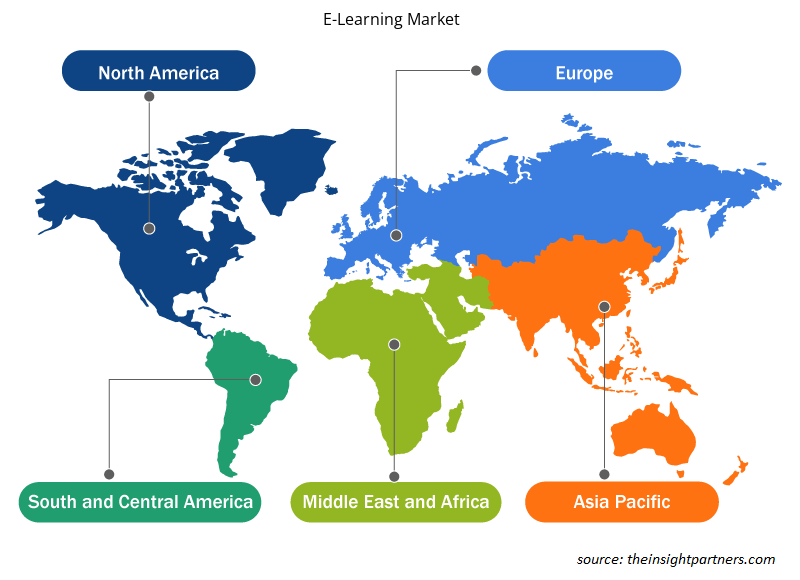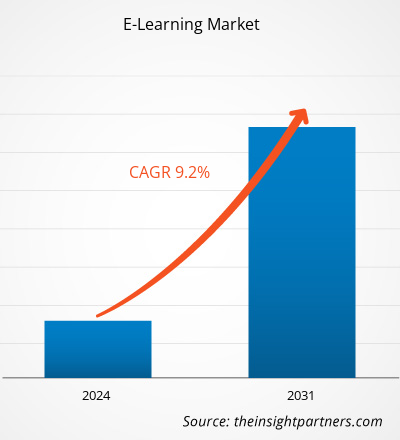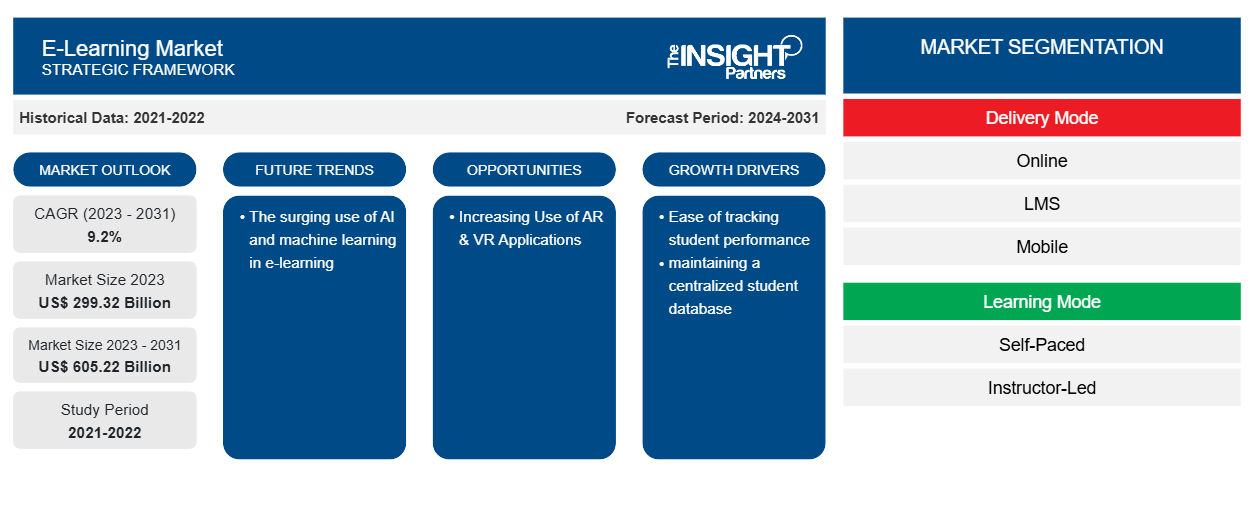Der E-Learning-Markt soll von 299,32 Milliarden US-Dollar im Jahr 2023 auf 605,22 Milliarden US-Dollar im Jahr 2031 anwachsen.Es wird erwartet, dass der Markt zwischen 2023 und 2031 eine durchschnittliche jährliche Wachstumsrate (CAGR) von 9,2 % verzeichnet. Der zunehmende Einsatz von KI und maschinellem Lernen im E-Learning dürfte ein wichtiger Trend auf dem Markt bleiben.
E-Learning-Marktanalyse
Online- und technologiebasierte Bildung hat die Präsenzbildung in Bezug auf Kosten, Zugänglichkeit, Zeit und Komfort überholt. Studenten können ihre Fähigkeiten verbessern, indem sie sich für Kurse von Top-Experten und Universitäten weltweit anmelden. Neben Studenten sind Berufstätige ein weiteres wichtiges Zielsegment für digitale Lernorganisationen. Online- Zertifizierungen sind im heutigen wettbewerbsorientierten Unternehmensumfeld immer beliebter geworden. In verschiedenen Branchen, darunter IT, BPOs, KPOs und Start-ups, wird eine kontinuierliche Verbesserung der Fähigkeiten erwartet. Unternehmensmitarbeiter nehmen zunehmend an Online-Kursen teil, um auf dem Laufenden zu bleiben, während die meisten Berufstätigen Zertifikate für ihre Arbeit verlangen.
E-Learning-Marktübersicht
Der Markt für digitales Lernen wächst in Entwicklungsländern rasant, und viele Start-ups drängen in diesen Sektor. Der Sektor des digitalen Lernens wird von Faktoren wie zunehmender Internetnutzung, Zeitbeschränkungen, geografischen Hindernissen und geringeren Kosten für Online-Schulungen angetrieben. Diese Faktoren fördern das Lernen im eigenen Tempo und erweitern seinen Umfang. Da die Nachfrage nach Qualitätszertifizierungen steigt, wenden sich immer mehr Menschen Online-Lernprogrammen zu.
Passen Sie diesen Bericht Ihren Anforderungen an
Sie erhalten kostenlos individuelle Anpassungen an jedem Bericht, einschließlich Teilen dieses Berichts oder einer Analyse auf Länderebene, eines Excel-Datenpakets sowie tolle Angebote und Rabatte für Start-ups und Universitäten.
-
Holen Sie sich die wichtigsten Markttrends aus diesem Bericht.Dieses KOSTENLOSE Beispiel umfasst eine Datenanalyse von Markttrends bis hin zu Schätzungen und Prognosen.
Treiber und Chancen des E-Learning-Marktes
Steigende Anzahl vernetzter Geräte und zunehmende Internetdurchdringung begünstigen den Markt
Die Nachfrage nach vernetzten Geräten wie Tablets, Laptops und Smartphones steigt weltweit. Die Nachfrage wird durch Homeoffice- und Lernszenarien noch weiter angekurbelt. Da Schüler aufgrund der Ausgangssperren und der Maßnahmen zur sozialen Distanzierung aufgrund der COVID-19-Pandemie nicht an der Schule oder am Unterricht teilnehmen konnten, wurde ihr Unterricht online durchgeführt, was letztendlich die Nachfrage nach Smartphones und Laptops ankurbelte. Darüber hinaus hat die Entwicklung der Telekommunikationsdienste weltweit zu einer Zunahme der Internetdurchdringung geführt, selbst in den entlegensten Gebieten der Welt, was den globalen E-Learning-Markt ergänzt.
Zunehmende Nutzung von AR- und VR-Anwendungen
In den letzten Jahren haben Augmented Reality (AR) und Virtual Reality (VR)-Technologien in der Bildungs- und Ausbildungsbranche als hervorragende Methoden zur Verbesserung des Lernerlebnisses an Attraktivität gewonnen. AR und VR ermöglichen Fernunterricht und flexibles Lernen, sodass Schüler von überall auf der Welt auf Schulungsmaterialien und Simulationen zugreifen können. Dies kann insbesondere dann nützlich sein, wenn Schüler nicht an persönlichen Schulungen teilnehmen können.
Segmentierungsanalyse des E-Learning-Marktberichts
Wichtige Segmente, die zur Ableitung der E-Learning-Marktanalyse beigetragen haben, sind Bereitstellungsmodus, Lernmodus und Endbenutzer.
- Basierend auf der Bereitstellungsart ist der E-Learning-Markt in Online, LMS, Mobil und Sonstige unterteilt. Das Online-Segment hatte im Jahr 2023 einen größeren Marktanteil.
- Nach Lernmodus ist der Markt in selbstgesteuertes Lernen und lehrergeführtes Lernen segmentiert.
- Nach Endnutzern ist der Markt in akademische und Unternehmensbereiche segmentiert. K-12 und höhere Bildungseinrichtungen sind die wichtigsten Untersegmente des Endnutzersegments.
E-Learning-Marktanteilsanalyse nach Geografie
Der geografische Umfang des E-Learning-Marktberichts ist hauptsächlich in fünf Regionen unterteilt: Nordamerika, Asien-Pazifik, Europa, Naher Osten und Afrika sowie Süd- und Mittelamerika.
Nordamerika dominierte den E-Learning-Marktanteil im Jahr 2023. Laut dem HurixDigital-Bericht 2023 sind die USA eines der weltweit führenden Länder hinsichtlich der erfolgreichen Implementierung von E-Learning im Bildungswesen.
Regionale Einblicke in den E-Learning-Markt
Die regionalen Trends und Faktoren, die den E-Learning-Markt im Prognosezeitraum beeinflussen, wurden von den Analysten von Insight Partners ausführlich erläutert. In diesem Abschnitt werden auch E-Learning-Marktsegmente und -Geografie in Nordamerika, Europa, im asiatisch-pazifischen Raum, im Nahen Osten und Afrika sowie in Süd- und Mittelamerika erörtert.

- Holen Sie sich die regionalspezifischen Daten für den E-Learning-Markt
Umfang des E-Learning-Marktberichts
| Berichtsattribut | Details |
|---|---|
| Marktgröße im Jahr 2023 | 299,32 Milliarden US-Dollar |
| Marktgröße bis 2031 | 605,22 Milliarden US-Dollar |
| Globale CAGR (2023 - 2031) | 9,2 % |
| Historische Daten | 2021-2022 |
| Prognosezeitraum | 2024–2031 |
| Abgedeckte Segmente |
Nach Liefermodus
|
| Abgedeckte Regionen und Länder |
Nordamerika
|
| Marktführer und wichtige Unternehmensprofile |
|
Dichte der E-Learning-Marktakteure: Deren Auswirkungen auf die Geschäftsdynamik
Der E-Learning-Markt wächst rasant, angetrieben durch die steigende Nachfrage der Endnutzer aufgrund von Faktoren wie sich entwickelnden Verbraucherpräferenzen, technologischen Fortschritten und einem größeren Bewusstsein für die Vorteile des Produkts. Mit steigender Nachfrage erweitern Unternehmen ihr Angebot, entwickeln Innovationen, um die Bedürfnisse der Verbraucher zu erfüllen, und nutzen neue Trends, was das Marktwachstum weiter ankurbelt.
Die Marktteilnehmerdichte bezieht sich auf die Verteilung der Firmen oder Unternehmen, die in einem bestimmten Markt oder einer bestimmten Branche tätig sind. Sie gibt an, wie viele Wettbewerber (Marktteilnehmer) in einem bestimmten Marktraum im Verhältnis zu seiner Größe oder seinem gesamten Marktwert präsent sind.
Die wichtigsten auf dem E-Learning-Markt tätigen Unternehmen sind:
- Kursra
- edX
- LinkedIn Learning
- Fähigkeiten teilen
- Skillsoft
- Udacity
Haftungsausschluss : Die oben aufgeführten Unternehmen sind nicht in einer bestimmten Reihenfolge aufgeführt.

- Überblick über die wichtigsten Akteure auf dem E-Learning-Markt
Neuigkeiten und aktuelle Entwicklungen zum E-Learning-Markt
Der E-Learning-Markt wird durch die Erhebung qualitativer und quantitativer Daten aus Primär- und Sekundärforschung bewertet, die wichtige Unternehmenspublikationen, Verbandsdaten und Datenbanken umfasst. Nachfolgend sind einige der Entwicklungen auf dem E-Learning-Markt aufgeführt:
- Die William Woods University (WWU) hat heute offiziell eine Vereinbarung mit Coursera, einer globalen Online-Lernplattform, bekannt gegeben, die den Zugang zu digitalen Inhalten, die für die heutige Arbeitswelt relevant sind, erheblich erweitern wird und WWU-Studenten, Mitarbeitern, Alumni und Universitätspartnern Kompetenztraining und branchenweit anerkannte Zertifizierungen für gefragte berufliche Fähigkeiten bietet. Die neue Partnerschaft wird es William Woods ermöglichen, auf Coursera mit Online-Kursen und Zertifikaten in einer Vielzahl von Disziplinen von über 325 Top-Universitäten und Unternehmen zu lernen und diese in den Lehrplan der Universität einzubinden, wodurch die akademische Erfahrung und die Arbeitsmarktfähigkeit jedes WWU-Studenten weiter verbessert werden. (Quelle: William Woods University, Pressemitteilung, Februar 2024)
- edX und Degreed haben eine erweiterte strategische Partnerschaft angekündigt, um Organisationen erstklassige Bildungsinhalte und Plattformlösungen bereitzustellen, die kompetenzbasiertes Lernen fördern. Jetzt ist edX For Business – eine erstklassige Inhaltslösung für Organisationen, die wirkungsvollere Lern- und Entwicklungsprogramme durchführen möchten – für Organisationen und ihre Mitarbeiter direkt innerhalb der Degreed-Plattform verfügbar. Dies ist Ausdruck einer konzertierten Anstrengung, neu zu definieren, wie Unternehmen Talente auf allen Ebenen ihrer Belegschaft schulen, weiterbilden und halten. (Quelle: edX, Pressemitteilung, Dezember 2023)
Abdeckung und Ergebnisse des E-Learning-Marktberichts
Der Bericht „E-Learning-Marktgröße und -Prognose (2021–2031)“ bietet eine detaillierte Analyse des Marktes, die die folgenden Bereiche abdeckt:
- E-Learning-Marktgröße und -Prognose auf globaler, regionaler und Länderebene für alle wichtigen Marktsegmente, die im Rahmen des Berichts abgedeckt sind
- E-Learning-Markttrends sowie Marktdynamik wie Treiber, Einschränkungen und wichtige Chancen
- Detaillierte PEST/Porters Five Forces- und SWOT-Analyse
- E-Learning-Marktanalyse mit wichtigen Markttrends, globalen und regionalen Rahmenbedingungen, wichtigen Akteuren, Vorschriften und aktuellen Marktentwicklungen
- Branchenlandschaft und Wettbewerbsanalyse mit Marktkonzentration, Heatmap-Analyse, prominenten Akteuren und aktuellen Entwicklungen für den E-Learning-Markt
- Detaillierte Firmenprofile
- Historische Analyse (2 Jahre), Basisjahr, Prognose (7 Jahre) mit CAGR
- PEST- und SWOT-Analyse
- Marktgröße Wert/Volumen – Global, Regional, Land
- Branchen- und Wettbewerbslandschaft
- Excel-Datensatz
Aktuelle Berichte
Erfahrungsberichte
Grund zum Kauf
- Fundierte Entscheidungsfindung
- Marktdynamik verstehen
- Wettbewerbsanalyse
- Kundeneinblicke
- Marktprognosen
- Risikominimierung
- Strategische Planung
- Investitionsbegründung
- Identifizierung neuer Märkte
- Verbesserung von Marketingstrategien
- Steigerung der Betriebseffizienz
- Anpassung an regulatorische Trends























 Kostenlose Probe anfordern für - E-Learning-Markt
Kostenlose Probe anfordern für - E-Learning-Markt